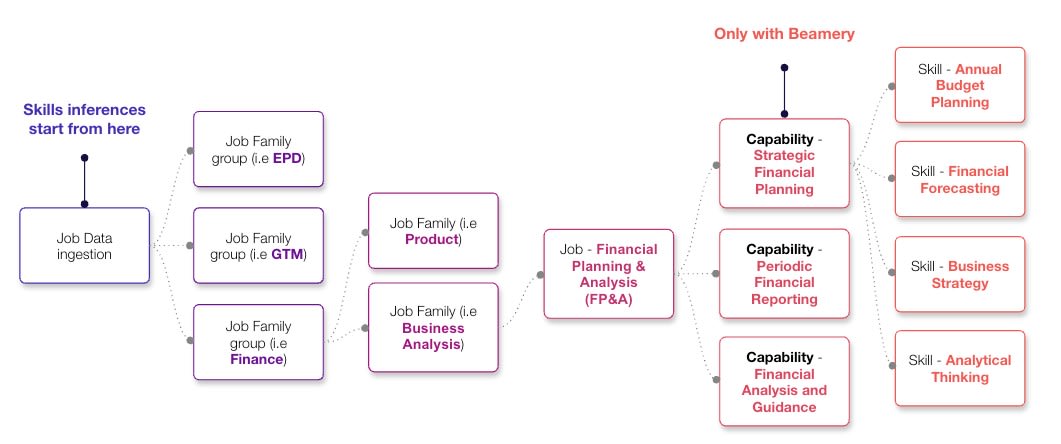The Importance Of Understanding Tasks In A Skills-First Organization
More and more companies – particularly large organizations – are embracing “skills”. Skills are the new language of work, the new currency of decision making, and embody a new approach to talent that truly aligns workforce plans with business goals. Why? Because they provide a fast, accurate and objective way to close skills gaps – skills gaps that are getting bigger by the day.
Seventy-three percent of business executives expect to continue to experience talent shortages over the next three years, and 70% of those respondents say they are getting creative about “sourcing for skills” rather than just considering job experience. – Deloitte
Deloitte research has found that skills-based organizations are 107% more likely to place talent effectively, 52% more likely to innovate, and 57% more likely to anticipate change and respond effectively and efficiently. In a world where “the skills gap” continues to be the most significant obstacle to business transformation – cited by 63% of employers as a main barrier to future-proofing their operations (World Economic Forum) – a more flexible approach to understanding and deploying talent to work is clearly critical.
At Beamery, we are huge advocates of the skills-based approach. We help companies visualize people and work through the lens of skills. We deliver user-friendly databases of skills-based talent profiles (from candidates to alumni) and dynamic job architectures outlining the skills (and proficiency) required to perform every role.
Our proprietary AI models can help normalize skills, infer skills, and connect skills data between a Talent CRM, HRIS, and learning platforms – providing accurate, real-time insights around skills supply and demand, tailored to the clients’ business.
The resulting “skills intelligence” means you can do the matching part easily at scale: that is, getting the right people into the right roles. Skills intelligence is the connective tissue that is making workforce planning more agile, talent acquisition more efficient, and internal mobility more effective.
But it’s not the whole story.
Tasks Matter
“Skills” make sense in some contexts. The L&D department may talk about skills needs and reskilling or upskilling – but most people would panic if you asked them what their “skills” were.
Tasks make more sense when you talk about work. If you were asked what your work involved, you’d list tasks. Those tasks can then be mapped to a collection of skills behind the scenes – because skills are the 0s and 1s; the thing “in between” that HR teams can interact with to make those matches.
For individuals and their managers, thinking in terms of tasks or capabilities makes the process much more intuitive.
Take a software engineer, for example. If you ask them what skills they have, they may struggle to articulate them comprehensively. But if you ask what they do, they might say:
- Writing and reviewing code
- Debugging and troubleshooting issues
- Collaborating with product managers to define features
- Conducting technical interviews
Each of these tasks correlates with a set of underlying skills. Writing and reviewing code could map to Python, Java, or C++ proficiency. Debugging could indicate problem-solving and attention to detail.
Starting with “tasks” helps individuals and managers describe work in a way that feels natural. It also helps you bring a role to life, because skills depend on context. Think about it: a skill like “data analysis” will look very different for a financial analyst compared to a marketing analyst. The key difference? The tasks they perform. Without this task-level granularity, skills frameworks can become overly generic and ineffective.
By analyzing the actual tasks involved, companies are also better able to redesign jobs to be more efficient, identifying redundancies, automation opportunities, or areas where upskilling is needed.
The Practical Implications For Skills-Based Organizations
Understanding the relationship between tasks and skills allows companies to build stronger skills-based job architectures, design better upskilling programs, and improve talent mobility. It also ensures that HR teams are not just collecting skills data but actually using it in ways that make sense for employees and managers alike.
A few practical applications:
- Job descriptions that resonate: Instead of only listing skills requirements, framing job descriptions around tasks can help candidates better understand expectations and self-assess their fit. Behind the scenes, skills will still be the thing that matches individuals to jobs.
- More effective career conversations: Managers can guide employees by discussing tasks they want to take on in the future, then connecting them to the skills they’ll need to develop.
- Smarter talent mobility: Internal mobility platforms can present opportunities in the context of tasks, making it easier for employees to see how their experience translates to new roles. Again, AI models will rely on underlying skills data to make those recommendations – but the suggestions will make sense to users, thanks to the language of tasks/capabilities.
A skills-first approach is the future of work, but for it to be truly effective, organizations need to translate between skills and the way people naturally think about their jobs: in terms of tasks.
For organizations serious about a skills-first approach, understanding tasks is essential. It’s what makes skills intelligence actionable – turning abstract skills data into real-world workforce decisions. At Beamery, we help companies connect the dots between tasks, skills, and people so they can unlock internal mobility, smarter hiring, and long-term workforce agility.
